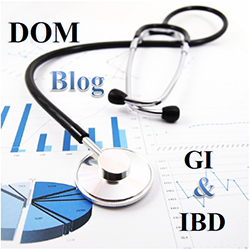The rates of inflammatory bowel disease (IBD)—i.e., Crohn’s disease (CD) and ulcerative colitis (UC)—in the population have grown over the last several decades. Reasons behind this growth are still being studied but likely involve a combination of genetics, gut bacteria, a dysfunctional immune system, and environmental factors. Increased use of fats and sugars in diets (aka a Western diet) in parts of Europe and Asia where IBD is now more common but was once rare suggests that dietary factors play a role in both CD and UC. While medications have a role in IBD therapy, patients have strong feelings about the effects of diet on preventing and improving their symptoms, and curing their disease. Occasionally, patients start specific diets for their IBD after discussion with their physician, but often they start these diets on their own.
 To understand how food affects the digestive tract in IBD, it’s important to briefly discuss how food is digested and how CD and UC can affect this process. When food is swallowed, it moves from the esophagus to the stomach where it is mixed and broken down, emptied into the small intestine where it is further broken down with vitamins and nutrients absorbed, and then moves to the colon where water is absorbed and undigested material and waste is stored. When appropriate, the material in the colon is passed as stool.
To understand how food affects the digestive tract in IBD, it’s important to briefly discuss how food is digested and how CD and UC can affect this process. When food is swallowed, it moves from the esophagus to the stomach where it is mixed and broken down, emptied into the small intestine where it is further broken down with vitamins and nutrients absorbed, and then moves to the colon where water is absorbed and undigested material and waste is stored. When appropriate, the material in the colon is passed as stool.
CD can affect any part of the gastrointestinal (GI) tract, which extends from the mouth to the anus, but it usually involves the small intestine and colon. UC only affects the colon. CD and UC lead to GI tract inflammation and this makes it difficult for the intestine to break down and absorb food and water. As a result, IBD can cause bloating, abdominal pain, and diarrhea.
Even after extensive research, scientists have not found foods or diets that cause IBD. Additionally, no research has linked food allergies to CD and UC. Though scientists have not found a direct correlation between food and IBD, diet is important in certain situations. In children, a liquid-only diet (aka enteral feeding) has been shown to decrease inflammation in IBD. In adults, however, this therapy is not effective. The liquid diet uses simple digestible foods and should be done with the help of a doctor or nutritionist. In CD, patients with a narrowing in their small intestine (aka a stricture) are at risk of a blockage and benefit from avoiding high fiber foods like certain vegetables (cabbage, cauliflower, broccoli) and fruit skins, whole grain breads and cereals, and beans. Some patients may also require a liquid diet depending on the stricture. IBD “flares” can also respond to changes in the diet. In these situations, again it can be best to be on a low-fiber diet. Foods high in fiber require further digestion by an already stressed intestinal tract potentially causing worse GI symptoms. Additionally, dairy products with lactose may be best avoided as an inflamed gut may have difficulty breaking down the sugars. Other food products that can worsen symptoms include alcohol and spicy or fatty foods. Importantly though, each patient has a unique set of food triggers.
The Internet and personal experiences of patients have led to the rise of several types of diets being used for IBD. We will discuss some of these diets here, but it is important to note that scientists have not studied these diets and with few exceptions, even though they may reduce symptoms, there is no evidence that they decrease inflammation in IBD. The different diets can be categorized into liquid, elimination, and restriction diets. We have already discussed the liquid-only diets. The elimination diet attempts to identify food triggers for GI symptoms by eliminating all suspect foods from the diet and then slowly reintroducing each food product. Restriction diets include the Paleolithic (Paleo) diet, the fermentable oligosaccharides, disaccharides, monosaccharides and polyols (FODMAP) diet, and the specific carbohydrate diet (SCD). Among the restrictive diets, the Paleo diet emphasizes not eating food produced and developed using current agricultural methods and emphasizes consuming meat from non-domesticated animals and non-cereal plant-based products. The FODMAP diet, more restrictive than the Paleo diet, restricts simple carbohydrates, lactose, processed meats, and certain fruits and vegetables. There is a lot of overlap between the SCD and FODMAP diet, but the SCD has less limitation on fruits and vegetables. In our experience, the SCD has been effective in decreasing inflammation in some IBD patients but this typically occurs when they are also on medications for their disease. This finding with the SCD needs to be further studied before any recommendations can be made. The SCD is a very restrictive diet, has to be strictly followed, and most patients cannot adhere to it.
Part of maintaining a healthy lifestyle in IBD involves eating a well-balanced diet including fruits, vegetables, protein, unsaturated fats, and complex carbohydrates. This is essential for maintaining an appropriate weight, obtaining the vitamins and minerals the body requires, and providing the best opportunity to treat IBD. It is not unusual for weight to fluctuate in IBD as patients may lose weight during a “flare” but gain weight while on steroids. There is a risk of unintentional weight loss with the elimination or restrictive diets. Discussion of diet with a provider or dietician can help ensure adequate nutrition intake.
There is an abundance of information on diet and IBD on the Internet and in the nonscientific literature, but unfortunately it is based on insufficient evidence. In adults, no large studies have found that certain foods or particular diets cause or help treat gut inflammation. Patients with strictures and those having “flares,” however, may notice less GI symptoms by making adjustments to their diet. In other IBD patients with GI symptoms, since elimination and restriction diets do not decrease symptoms for everyone, we recommend keeping a daily journal recording both food intake and GI symptoms. This method recognizes individuals have different causes for their symptoms and attempts to identify specific food triggers. Sharing the journal with your primary physician and a GI specialist can help identify potential resolutions to remedy your IBD woes.
This blog topic was originally posted Jan. 31, 2014.


